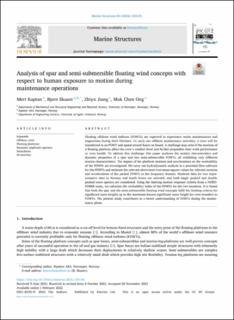| dc.contributor.author | Kaptan, Mert | |
| dc.contributor.author | Skaare, Bjørn | |
| dc.contributor.author | Jiang, Zhiyu | |
| dc.contributor.author | Ong, Muk Chen | |
| dc.date.accessioned | 2023-01-20T08:42:52Z | |
| dc.date.available | 2023-01-20T08:42:52Z | |
| dc.date.created | 2022-05-18T13:08:06Z | |
| dc.date.issued | 2022 | |
| dc.identifier.citation | Kaptan, M., Skaare, B., Jiang, Z., & Ong, M. C. (2022). Analysis of spar and semi-submersible floating wind concepts with respect to human exposure to motion during maintenance operations. Marine Structures, 83, 103145. | en_US |
| dc.identifier.issn | 0951-8339 | |
| dc.identifier.uri | https://hdl.handle.net/11250/3044817 | |
| dc.description.abstract | Floating offshore wind turbines (FOWTs) are expected to experience onsite maintenances and inspections during their lifetimes. To carry out offshore maintenance activities, a crew will be transferred to an FOWT and spend several hours on board. A challenge may arise if the motions of a floating platform affect the crew's comfort level and further jeopardise their work performance or even health. To address this challenge, this paper analyses the motion characteristics and dynamic properties of a spar and two semi-submersible FOWTs, all exhibiting very different motion characteristics. The impact of the platform motions and accelerations on the workability of the FOWTs are investigated. We carry out hydrodynamic analysis in a potential-flow software for the FOWTs and estimate the relevant short-term root-mean-square values for relevant motions and accelerations of the parked FOWTs in the frequency domain. Hindcast data for two representative sites in Norway and South Korea are selected, and both single peaked and double peaked wave spectra are considered. Using the limiting motion response criteria from a NORDFORSK study, we calculate the workability index of the FOWTs for the two locations. It is found that both the spar and the semi-submersible floating wind concepts fulfil the limiting criteria for significant wave heights up to the maximum known significant wave height for crew transfers to FOWTs. The present study contributes to a better understanding of FOWTs during the maintenance phase. | en_US |
| dc.language.iso | eng | en_US |
| dc.publisher | Elsevier | en_US |
| dc.rights | Navngivelse 4.0 Internasjonal | * |
| dc.rights.uri | http://creativecommons.org/licenses/by/4.0/deed.no | * |
| dc.title | Analysis of spar and semi-submersible floating wind concepts with respect to human exposure to motion during maintenance operations | en_US |
| dc.title.alternative | Analysis of spar and semi-submersible floating wind concepts with respect to human exposure to motion during maintenance operations | en_US |
| dc.type | Peer reviewed | en_US |
| dc.type | Journal article | en_US |
| dc.description.version | publishedVersion | en_US |
| dc.rights.holder | The author | en_US |
| dc.subject.nsi | VDP::Teknologi: 500 | en_US |
| dc.source.volume | 83 | en_US |
| dc.source.journal | Marine Structures | en_US |
| dc.identifier.doi | 10.1016/j.marstruc.2021.103145 | |
| dc.identifier.cristin | 2025211 | |
| cristin.ispublished | true | |
| cristin.fulltext | original | |
| cristin.qualitycode | 2 | |

